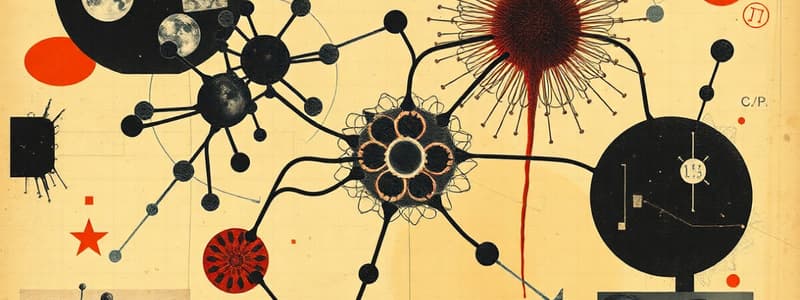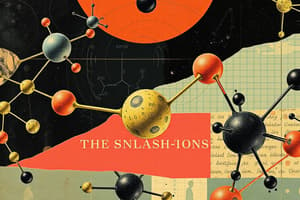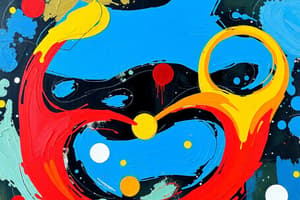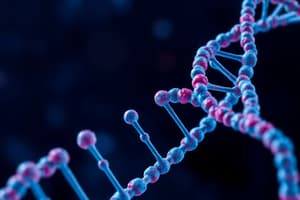Podcast
Questions and Answers
What is the primary function of ribosomes within the cell?
What is the primary function of ribosomes within the cell?
- To synthesize proteins (correct)
- To store genetic information
- To generate energy
- To regulate cell division
Which of the following accurately describes the conservation of mass during a chemical reaction?
Which of the following accurately describes the conservation of mass during a chemical reaction?
- Mass is lost as energy is released
- Only organic compounds conserve mass
- Total mass of reactants equals total mass of products (correct)
- Atoms are converted to energy
Which component of blood is primarily responsible for oxygen transport?
Which component of blood is primarily responsible for oxygen transport?
- White blood cells
- Platelets
- Red blood cells (correct)
- Plasma
What is a primary consequence of global warming?
What is a primary consequence of global warming?
What is the role of chlorophyll in photosynthesis?
What is the role of chlorophyll in photosynthesis?
Flashcards
Chemical Bond
Chemical Bond
A chemical bond is a force that holds atoms together in molecules or compounds. It is formed by the sharing or transfer of electrons between atoms.
What are ions?
What are ions?
Ions are atoms that have gained or lost electrons, resulting in a positive or negative charge. For example, a sodium ion (Na+) has lost an electron, while a chloride ion (Cl-) has gained one.
What is Photosynthesis?
What is Photosynthesis?
Photosynthesis is the process by which plants convert light energy into chemical energy (sugars) using chlorophyll. It takes place in chloroplasts within plant cells. The basic formula: Carbon dioxide + water + sunlight → glucose + oxygen.
What is the cell cycle?
What is the cell cycle?
Signup and view all the flashcards
What's the circulatory system?
What's the circulatory system?
Signup and view all the flashcards
Study Notes
Chemical Bonding
- Chemical bonds form when atoms share or transfer electrons to achieve a stable electron configuration
- Ions are charged particles formed when atoms lose or gain electrons
- Conservation of mass dictates that mass is neither created nor destroyed in a chemical reaction
Balancing Chemical Equations
- Skeleton equations show reactants and products without balancing
- Balancing equations ensures equal numbers of atoms on both sides
Types of Chemical Reactions
- Reactions can be classified based on patterns (e.g., synthesis, decomposition, single displacement)
pH and Indicators
- pH indicates acidity or basicity; indicators change color to show pH changes
Chemical Names and Formulas
- Understanding chemical names and formulas is vital to represent compounds
Cell Structure and Function
- Cells are the basic units of life; each contains organelles with specific roles
Cell Specialization
- Cells differentiate into specialized types to perform specific functions
Cell Cycle
- The cell cycle includes stages of growth, DNA replication, and division
Blood Flow Pathway
- Blood flows through the heart and circulatory system, carrying oxygen and nutrients
Photosynthesis
- Photosynthesis is the process where plants convert light energy to chemical energy
Digestive System
- The digestive system breaks down food for nutrient absorption
Blood Cells
- Blood contains various cell types (red blood cells, white blood cells, platelets)
Respiration
- Breathing involves mechanics of inhaling and exhaling air
Plant Tissues
- Plants have specialized tissues for support and transport
Tumours
- Tumours are abnormal growths of cells
Heart Structure
- The heart comprises chambers and valves crucial for blood circulation
Circulatory System
- The circulatory system transports blood and nutrients throughout the body
High Blood Pressure
- High blood pressure (hypertension) can lead to health issues
Exercise and Body Systems
- Exercise impacts different body systems
Light Production
- Light production involves converting energy to light
Light and Optics
- The speed of light is a constant; different mediums affect its speed; Refractive index (RI) calculations relate to light's speed in different mediums. Different types of mirrors and lenses create and modify images.
Optics - Mirrors and Lenses
- Various types of lenses and mirrors (concave, convex) produce different image types (real/virtual, upright/inverted, enlarged/reduced); Using specific rules to accurately draw ray diagrams
The Human Eye
- The human eye focuses images to interpret sight
- Vision problems include nearsightedness and farsightedness
Climate Change
- Gases like carbon dioxide contribute to climate change
Weather Patterns
- Understanding weather patterns involves various atmospheric factors
Atmosphere Layers
- The atmosphere has various layers
Global Warming
- Global warming is a global issue with serious environmental implications
Deforestation
- Deforestation has profound impacts on the environment
Studying That Suits You
Use AI to generate personalized quizzes and flashcards to suit your learning preferences.




